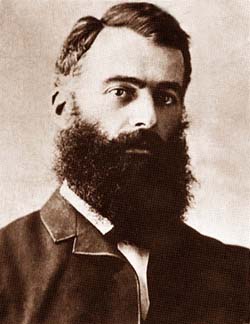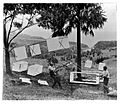Lawrence Hargrave facts for kids
Quick facts for kids
Lawrence Hargrave
|
|
|---|---|

Lawrence Hargrave, c. 1890
|
|
| Born | 29 January 1850 Greenwich, England
|
| Died | 6 July 1915 (aged 65) |
| Nationality | Australian |
Lawrence Hargrave (born January 29, 1850 – died July 6, 1915) was a clever Australian engineer, explorer, and inventor. He was a true pioneer in the world of aeronautics, which is the science of flight. His ideas and inventions helped pave the way for modern airplanes.
Contents
Early Life and Adventures
Lawrence Hargrave was born in Greenwich, England. When he was 15, his family moved to Sydney, Australia. He first worked as an engineering apprentice, learning how to build and fix machines. This experience was very useful later when he started building his own models.
Hargrave loved adventure and exploring. As a young engineer, he sailed on several trips to New Guinea. He explored rivers and land, even surviving a shipwreck! He also worked checking out the pearl diving industry.
In 1878, he became an assistant at the Sydney Observatory, where he studied the stars. After about five years, he had enough money to live comfortably. He then decided to spend the rest of his life doing what he loved most: research and inventing.
Flying Machines and Big Ideas
Lawrence Hargrave was fascinated by flight from a young age. He especially loved watching birds fly. When he inherited money in 1885, he left his job at the observatory. He moved to Stanwell Park, a windy place perfect for his experiments. Today, it's a famous spot for hang gliding and paragliding!
Hargrave invented many things, but he never applied for a patent. A patent protects an invention so only the inventor can make money from it. But Hargrave believed that sharing his discoveries freely would help science move forward faster. He thought that if everyone shared their ideas, flying machines would be invented much sooner.
He wrote in 1893:
Workers must root out the idea [that] by keeping the results of their labours to themselves[,] a fortune will be assured to them. Patent fees are much wasted money. The flying machine of the future will not be born fully fledged and capable of a flight for 1000 miles or so. Like everything else it must be evolved gradually. The first difficulty is to get a thing that will fly at all. When this is made, a full description should be published as an aid to others. Excellence of design and workmanship will always defy competition.
Key Inventions
Hargrave made three very important inventions that helped others build successful flying machines:
- Curved Wings (Aerofoils): He studied how the curved shape of a bird's wing helps it fly. He designed wings that were thicker at the front, which made them much better at creating lift.
- The Box Kite: In 1893, he invented the box kite. This kite design was much more stable and created more lift than older, flat kites. It was a huge step forward for early gliders.
- The Rotary Engine: He also worked on the rotary engine. This type of engine was light and powerful for its time. It was used in many early airplanes until about 1920. Hargrave couldn't make his engines powerful enough for his own flying machines because the materials and tools available then weren't good enough.
Hargrave shared all his findings with the Royal Society of New South Wales. He wrote many papers explaining his experiments and conclusions.
Lifting Off the Ground
One of Hargrave's most famous experiments happened on November 12, 1894. At Stanwell Park Beach, he successfully lifted himself 16 feet (about 5 meters) off the ground! He did this using a train of four of his box kites. His caretaker, James Swain, helped him. The kites were tied to sandbags using a special scale to measure the pull. Hargrave even took instruments with him to measure the wind speed and the angle of the kite line.
This experiment showed that the box kite was a very stable way to get into the air. Hargrave said it proved that a simple machine could be carried and flown by one person. He also said it was a safe way to test flying machines without much risk.
News of his success spread around the world. The United States weather bureau started using box kites for observing weather. The idea of the box kite was also used in early gliders and airplanes. For example, in 1906, Alberto Santos-Dumont used the box-kite idea for his first successful airplane flight in Europe.
Lasting Impact
Even though Hargrave's work was very important, it wasn't fully appreciated during his lifetime. He wanted to give his models to the state of New South Wales. But there were delays, and about 100 of his models ended up in the Deutsches Museum in Munich, Germany.
Hargrave's only son, Geoffrey, was sadly killed in May 1915 during World War I. Lawrence Hargrave himself passed away in July 1915 after an operation. He was buried in Waverley Cemetery, overlooking the ocean.
Lawrence Hargrave was an amazing experimenter. He was optimistic, never giving up even when things failed. He was also very humble and unselfish, always refusing to patent his inventions. He just wanted to add to human knowledge. Many people didn't believe in his work at first. But Professor Richard Threlfall called Hargrave the "inventor of human flight." Hargrave's work truly helped bring about the age of flight.
Honors and Memorials
Lawrence Hargrave's contributions to flight are remembered in many ways:
- From 1966 to 1994, his picture appeared on the back of the Australian $20 banknote.
- An opera called Fly was created about his life in 1984.
- There is a memorial stone at Bald Hill, near where he did his famous kite lift.
- A road called Lawrence Hargrave Drive stretches along the coast in New South Wales.
- In 1994, a celebration and re-enactment of his man-lifting kite experiment took place at Stanwell Park.
- A professorship at Sydney University and a library at Monash University are named in his honor.
- Australia's largest airline, Qantas, named one of its huge Airbus A380 airplanes after him.
- A building at his old school in England was named after him in 2017.
- A sculpture called Winged Figure by Bert Flugelman honors him at the base of Mount Keira.
Images for kids
-
Hargrave (seated) and Swain demonstrate the manlift kites at Stanwell Park beach, November 1894.
See also
 In Spanish: Lawrence Hargrave para niños
In Spanish: Lawrence Hargrave para niños





